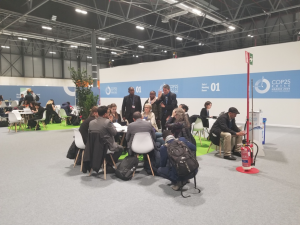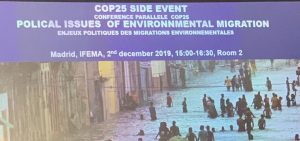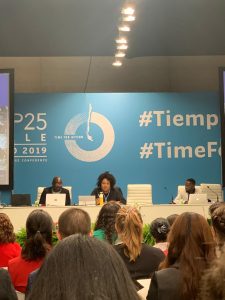Pradnya Bhandari
Attendance at the COP is clearly ramping up as all the meetings, side events, pavilion events, and even hallways of the COP are becoming more and more crowded. As attendance grows, so does the chance for peaceful protests and I witnessed my first today. It was fascinating to see how many people felt so strongly about the actions of a private sector company. There is also a big protest planned for tomorrow that is met with support with protestors in Chile, parts of America, and even Durham. The frustration of these individuals is valid and their voices need to be heard and protesting provides an avenue for them to express these sentiments. Especially in the context of this COP and the sudden location change because of civil unrest, it is more important than ever to understand how climate change affects the daily lives of citizens around the world. When discussing large international agreements, these minute details can sometimes be lost and the protests ensure that human rights and quality of life are top of mind issues for negotiators. Public interest and desire for actionable climate change agreements is a key driver motivating delegators from all parties to work together to come to a decision on Article 6 and the Paris Agreement. While only four days of the COP has passed, there isn’t much time left for various parties to come to a consensus on the mechanisms through which the agreement will be achieved.
Forrest Robinette
Is this journal reflection 3 or 4? Is today Thursday or Monday? Where am I? Who am I?! The COP is such a wonderful but such a profoundly overwhelming experience that I don’t know if I’ve been here for five days or a month!
Today I got to see the next steps of the negotiations I have been “following” on Response Measures. At first, I thought I would be excluded since the meetings were listed as informal informals, or “inf infs” as the cool kids say (all the negotiations say that too). I had been told these meetings are closed to observers (i.e. me); however, my client gave me the pro tip that whether or not observers are allowed in is actually at the discretion of the chair. I asked, and she kindly let me in!
The negotiations for this topic still seem to be moving pretty slowly, given their deadline for a draft is this Saturday. I’ll be sad I can’t follow the developments next week.
Aside from Response Measures, I attended the RINGO, the research NGO morning briefing. Then I bopped into a number of side events and pavilion events that covered, among other things, indigenous voices in fair transition, SDG 8, youth advocacy in climate action, and carbon capture technologies.
Today, a classmate and I witnessed a protest at an event on private sector climate action. I just learned there is, essentially, a protest of the private sector pretty much every year at the COP. This issue is front and center in Article 6, which explores international carbon markets and private market mechanisms. For this blog, I’m not touching the issue of what role the private sector can and should play in climate action. I’ll let someone else get in trouble for that!
Emma Hughes
This was the fourth day of COP 25. This week has flown by and we only have one more day left of the conference and one more day left in Madrid. As the week has moved along, it seems that negotiations have become more technical by the minute. The side events I attend seem to focus on the voices not being brought to the table and the stakeholders not included in the decision-making. From what I can tell this problem of accessibility to the COP is exacerbated by the late change of venue from Santiago to Madrid. How are negotiators and parties supposed to be making decisions for people when they aren’t always a part of the conversation and when these groups are involved in the conversation, they aren’t always involved in the decision-making process. Now, I think over time this problem has been partially addressed and I’ve seen that comment made in many of the side events I attended. The most recent example would be from today on From the Boreal to the Arctic: Indigenous knowledge and leadership for climate mitigation and adaptation. But there is no mention of these stakeholder groups in the actual negotiations from what I can tell.
Over this semester and this week, I think I have begun to scratch the surface on the many procedures of the UNFCCC. That being said, I’m excited to see tomorrow how these processes interact and respond to the planned climate strike scheduled for tomorrow and the potential impacts it may have on negotiations.
Melinda Melvin
Today was an interesting and slightly slower day for me during which I got to attend some events unrelated to Article 6 and carbon markets. It was surprising to me that since Tuesday when negotiations started, almost no progress has been made on the technical issues of the guidance on Article 6. The Parties were noticeably disgruntled during the informal consultation today after a closed session had taken place in the morning, and only about 30 minutes of actual discussion of the text happened. The end of the negotiation devolved into numerous Points of Order as Parties objected to how the facilitators were running the negotiation sessions.
With very little happening on Article 6 (that was open to observers, at least), I took the chance to attend the Business and Industry Non-Governmental Orgs (BINGO) daily briefing and learned more about what the private sector was paying attention to at the COP. I also got to attend an event hosted by World Wildlife Fund on renewable energy development in Southeast Asia and learned more about the barriers and opportunities for renewable energy investment and deployment in the region. One of the more interesting events of the day, however, was a protest that took place during an event about private sector engagement in nature-based solutions. This launch event, which had speakers from Shell and other companies, was so crowded that I couldn’t get in the tiny room. Twenty minutes in, about 20 protesters put their hands over their ears and walked out of the meeting. This launched an internal debate about the philosophical merits and perils of nature-based solutions that I mulled over the rest of the evening.
While I was unable to get into the room, I was able to meet several interesting people outside who have worked in carbon markets, including an Italian energy executive who had been a technical negotiator in the early years of the COP and on the Kyoto Protocol mechanisms, and carbon market developers from Guatemala and Colombia. Overall, it was a good day of learning and engaging with those active in the field. I’m sad to think tomorrow is our last day!
Shakes Dlamini
Today I followed different side events of Energy transition for developing nations. It was interesting to hear the varied perspectives and challenges that developing countries in different regions face. For instance, quite a number of the developing countries in South East Asia still have a significant number of fossil-fueled power plants in the pipeline to energize the growth of their economies. However, it was interesting to learn that the deployment of renewable energies could be viable in these countries if the governments could redirect the funds that are being pumped into fossil fuels towards renewable energy. This point brought home the level of risk aversion that a lot of governments have towards renewable energies since hence they choose to finance traditional forms of power generation and expecting the private sector to advance their renewable energy mandate.
However, as a clean energy enthusiast, it was exciting to hear the different exciting developments in the energy sector such as new technologies being developed, innovative financing strategies that align with NDC’s and the immense potential developing countries to utilize renewable energy to hit two birds with one stone. Through the deployment of renewable energy, developing countries take climate action and progress towards meeting their NDCs while simultaneously meeting the supply need for energy to their citizens.
Yared Hurisa
In my fourth day, I was able to attend two grand events. The first one is ‘Pressing Record on Climate Action: Data Meeting on tracking progress 2020-23. This meeting was organized to aid implementation, bolster credibility, and inform strategies ahead of the next Global Stocktake in 2023. The objective of the meeting was to put in motion a framework towards establishing metrics for tracking progress. This will enable cooperative and individual climate actions to be tracked in such a way that they will ultimately appear on the Global Climate Action portal and be utilized by the broader analytical and research community.
The second major event and the associated side events that I have been following up was on the loss and damage. As such, I witnessed that this key issue is being received increased attention on the global agenda. This can be reflected by the several discussions made on loss and damage that continued throughout much of the day. I saw that progress is emerging on the issue with, but some divisions among parties, particularly on finance. Delegates addressing loss and worked into the night.

G77 and China members of the team discussing their position before the meeting
To this end, I got a chance to assist the communication team of the IISD that undertook an event on removing fuel subsidies as a part of emission reduction at the Nordic Pavilion. Apart from the theme of the workshop, this was important avenue to network with the event organizers.





